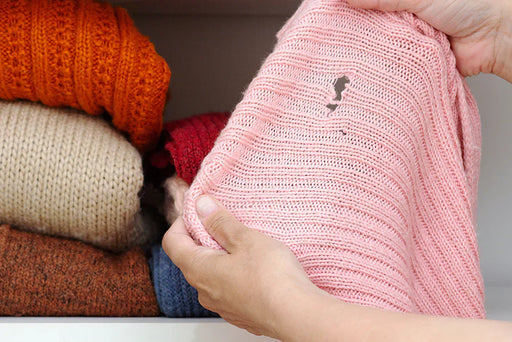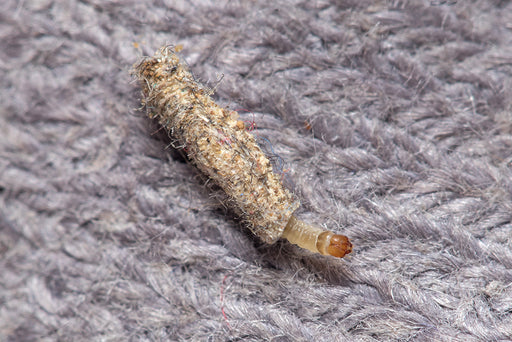Where Do Moths Come From?

Where Do Moths Come From, and Why the Heck are they In My Home?
Finding Clothes Moths or Pantry Moths in your house can be a distressing experience. Not only are moth larvae known to wreak havoc on clothing and food, but adult moths can be irritating, messy, and downright bothersome.
So exactly where do Moths come from, why are they in your house, and what can you do about it? That’s what we are here to examine!
A Bit About Moths and Where They Come From
Moths can be found all over the world. Whether you live in Europe, Asia, Canada, Mexico, or the United States, moths are likely to start appearing each year as the weather warms up. Many different species of moths begin maturing and fluttering about in the spring and early summer months. While some moths are not particularly problematic, others can cause a lot of issues inside a house.
The most problematic types of moths are Clothes Moths and Pantry Moths. Clothes Moth Larvae chew holes through clothing, carpets, curtains, and any fabric made using natural materials like wool, silk, or fur. Pantry Moth Larvae eat cereals, grains, flours, and other dry goods, leaving behind casings and frass.
The scientific name for the Clothes Moth is Tineola bisselliella. These moths are also known as Webbing Clothes Moths and come from the family Tineidae. The Pantry Moth is also dubbed the Indian Meal Moth, Grain Moth, or Flour Moth. It is scientifically known as Plodia interpunctella. This moth comes from the family Pyralidae.
How Moths Get Into Houses
Moths can come into your house like any other insect. For instance, in the northwestern United States, Miller Moths, Clover Moths, Looper Moths, Antler Moths, and other non-pestilent moths will fly towards a light source in your home. This could be via an open door, window, or crack in your weatherstripping.
These moths are better suited for the outdoors and aren’t usually interested in infesting anything. Instead, they prefer to feed on nectar, field crops, or rotten fruit. These moths are annoying but are not terribly destructive.
Some Miller Moths migrate as well, causing a plague-like effect in specific areas in the northern and western United States. They differ from pest moths in their colouration, patterned wings, and size. If you find these larger moths inside, you can simply toss them back outside where they belong.

Pestilent moths, on the other hand, are a different story. Pest moths are less decorative and smaller than common moths. Pesky destructive moths like Carpet Moths, Clothes Moths, and Pantry Moths can enter homes by flying in or through a combination of contamination and subterfuge methods. These moths seek undisturbed food sources where they lay their eggs that then hatch into ravenous moth larvae. The moth larvae can be very destructive.
In many cases, infestations will actually begin in the egg stage. That is to say, moth infestations most often start when you bring clothing or food items into your home that are already contaminated with moth eggs. These eggs then hatch into famished moth larvae that cause disgusting destruction through their feeding habits. Any items that are left unattended for long periods could become a target for adult moths looking to lay their eggs.
Ways Moths Get Into Homes:
- Open doors or windows
- Cracks in weatherstripping
- Hitching a ride in rolled-up carpets or fabrics
- By laying eggs and contaminating fabric or pantry goods
- In birdseed or other large quantities of seed or grain
- On secondhand furniture or clothing
- By laying eggs on new carpets in warehouses

Why Moths Enter Homes:
- To find dark, undisturbed areas to lay eggs
- They detect the presence of a food source for future moth larvae
- Because the eggs were laid on or in something and you unwittingly brought it inside
- On accident, looking for a light source at night to bash into
As you can see, there are plenty of ways that moths can get into a home. The key is Moth Prevention- stopping them from gaining access to the inside of your house in the first place.
How to Keep Moths at Bay:
- Freezing items for 72 hours before bringing them inside
- Treating fabrics and furniture with moth-killing sprays
- Using moth prevention methods like moth repellents, herbal sachets, cedar, or repelling sprays
- Setting up MothPrevention Moth Traps in entryways, garages, closets, attics, and pantries
- Keeping your doors and windows closed, especially at night or when you notice lots of moths around
FAQs About Moths, Where they Come From, and What to Do About It
Now that you have a little more insight into some of the most common moth species and their motives, let’s go over some specific questions that pertain to moths. In this FAQ section, we will discuss where different moths come from, why they want to be inside your house, and what you can do about it.
Where do Indian Meal Moths come from?
Indian Meal Moths commonly enter your home through food items that are already infested with moth eggs or moth larvae. In some circumstances, these moths can be even brought into your home by rodents that stash contaminated food in nooks and crannies. Indian Meal Moths have four lifecycle stages which are egg, larva, pupa, and adult.
To prevent Indian Meal Moths, be sure to check all items before bringing them into your home. For example, if you are buying a large bag of birdseed, check it for Meal Moth Larvae. If you notice larvae in any food items, get rid of those items right away and then treat your pantry for a potential moth infestation. Keep food items in sealed containers and use food-safe moth sprays and moth deterrents. You should also clean your pantry and any other food/animal feed storage areas (like barns, sheds, etc,) regularly.

Where do Pantry Moths come from?
Pantry Moths may refer to a few different types of moths that eat grain. These are the Mediterranean Flour Moth, White Shouldered House Moth, and Indian Meal Moth. Different species of grain-consuming moths can be found all over the world.
Pretty much anywhere that people live, Grain Moths and Pantry Moths can be found. These insects often enter homes by flying through open doors and windows or by laying their moth eggs inside of dry goods and food items that are then carried into the house.
Where do moths come from in the house?
Moths can come into your house through food or fabric items that are contaminated with moth eggs or moth larvae. These items are usually unwittingly carried in from the outside. Used furniture, clothing, and rolls of carpet are common hiding places for moth larvae or eggs.
Large bags of grain, flour, animal feed, and birdseed can also contain moth larvae or eggs. Moths can also enter homes through cracks, crevices, open doors, or open windows.
If you notice moths in your house and don't know where they are coming from, you may want to check your attic, garage, or pantry. Moths also sometimes live underneath carpets or inside of walls. If you see many small moths fluttering about, it might be time to go through your pantry goods.
Indian Meal Moths are known for showing up unexpectedly in large numbers. Usually, this happens because moth eggs hidden inside of unprotected grain items have hatched and matured into adults. These adults then emerge and fly about, perplexing homeowners with their presence.
How do I get rid of moths in my house?
If you have moths in your house, there are many effective pest control options at your disposal. To get rid of moths, first, find out what kind of moths you are dealing with. The three most common types of moths found in a home are Clothes Moths, Pantry Moths, and other non-pestilent moths.
For a moth infestation in your closet, garage, or attic, you should treat your home for Clothes Moths. Moth Traps, moth killing sprays, and moth bombs, are extremely effective. Then, you can use moth deterrents and herbal sachets to prevent these insects from entering your house again. Going forward, be sure to treat all used or second-hand items for moth eggs before bringing them into your home. Cleaning regularly can also help keep moths away.

If you have Pantry Moths, you will want to find the source of the infestation and get rid of it. Usually, this will be in exposed grain or flour items. Animal feed and bird seed may also be a hotbed for Pantry Moth Larvae. After eliminating the source of the problem, check all of your dry goods for moth larvae or evidence of larvae. If in doubt, toss it out. Clean your entire pantry as thoroughly as possible, position MothPrevention Pantry Moth Traps to monitor for further presence of moths, and use moth repellents to help prevent re-infestation.
For other non-pestilent moths like Antler Moths or Miller moths, just shut your doors and windows at night. To keep from attracting more moths, turn your lights off at night as well, especially if you have porch lights near a screened door or open window.
Carpet Moths where do they come from?
What about Carpet Moths? Carpet Moths usually live outdoors where they feed on bird feathers, keratin, and discarded animal fur or skin. These moths usually get into the house as eggs. They can be accidentally picked up on shoes or carried in on old scraps of carpet. Any textile-based item that has been outside for a long time and left unattended could attract Carpet Moths. MothPrevention Carpet Moth Traps are proven to be very effective at catching and killing the hatched moth eggs, and you simply just lay them near to the afffected area of carpet.
Why do I suddenly have moths in my house?
If you are noticing an explosion of moths in your house, there could be a few causes. For one thing, the previous generation of moth larvae could have matured and is now emerging in your house. This means that you had a moth infestation somewhere in your home that you were unaware of.
Another reason is the presence of migrating Miller Moths. Miller Moths are annoying but generally harmless. They migrate across the northern and western United States and tend to avoid daylight. They come out at night and are often attracted to artificial lights.
What kills moths instantly?

Moth Traps significantly reduce the numbers of sexually active adult male moths by attracting them to the sticky pheromones on the strip, helping break the breeding cycle. You will also get an indication as to the size of your moth problem. Moth Killing Spray and Moth Bombs kill these insects instantly. Or, you could swat them with a newspaper although this may get tiresome really quickly! A great chemical-free way to kill moth eggs within grain products or contaminated fabric is to freeze for 72 hours!
About MothPrevention
MothPrevention® speak to customers every day about their clothes moth issues - clothes moths are a species that are ever increasing and that can cause significant damage to clothes, carpets and other home textiles.
To date, we’ve helped over 250,000 customers deal with their moth problems. We have developed professional grade solutions including proprietary pheromones and trap design engineered to the highest production standards.





